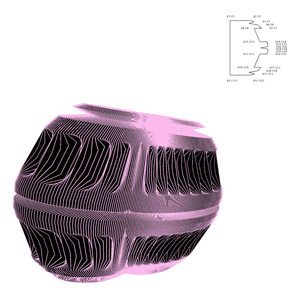Inspiration for a new piece comes from many sources, such as; nature, emotion, physical structures, life around us. However once the idea has been drawn and written down, the next step is to experience and understand the form as a 3D image. This enables me to tweak the design or in a few cases drop it all together, before I start book folding. The transition from ideas into a 3D image can be at times a complex one and involves a knowledge of basic mathematical principles, as well as programming skills.  These images were created using Processing, which is an open-source computer programming language and integrated development environment built for the electronic arts, new media art, and visual design communities.
These images were created using Processing, which is an open-source computer programming language and integrated development environment built for the electronic arts, new media art, and visual design communities.
Not all ideas can be represented within a book, there are restrictions, such as; dimensions, the pages being joined to the binding, papers ability to fold in on itself. The transition from 3D image to the first fold is often a complex one.
| click image for further information | ||
 |
 |
 |
| concertina 3d | vertebrae 3d | eclipse 3d |
 |
 |
 |
| resonance 3d | edifice 3d | rotation 3d |
 |
 |
 |
| babs 3d | snitch 3d | union jack 3d |
 |
 |
 |
| stellar 3d | resurrection 3d | screw thread 3d |
 |
||
| pod 3d | ||

